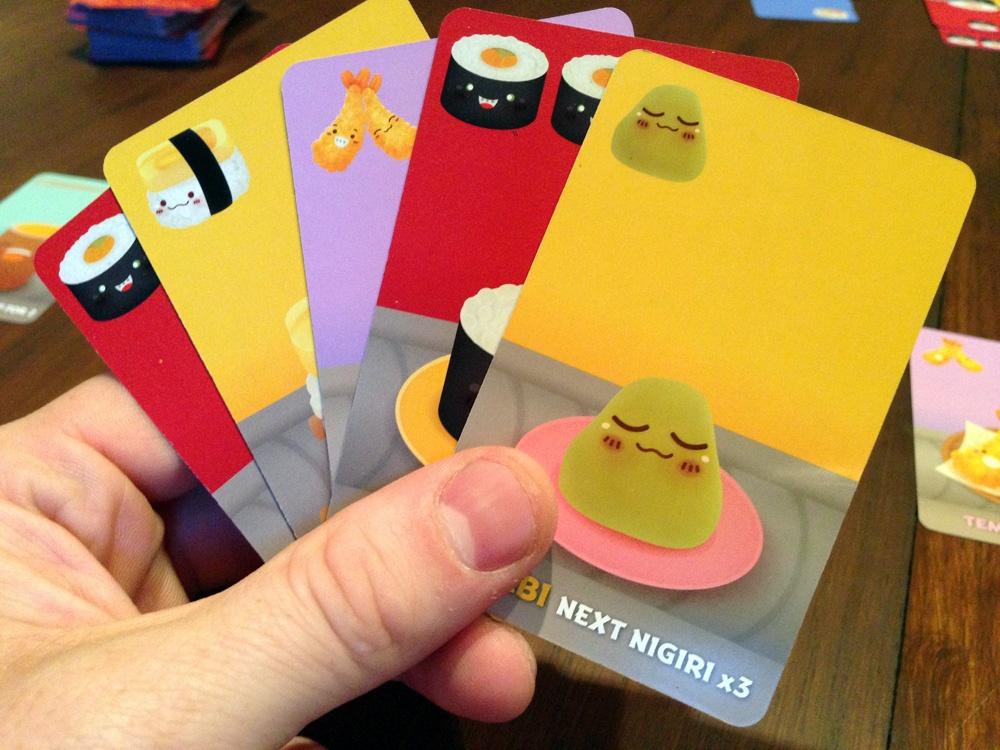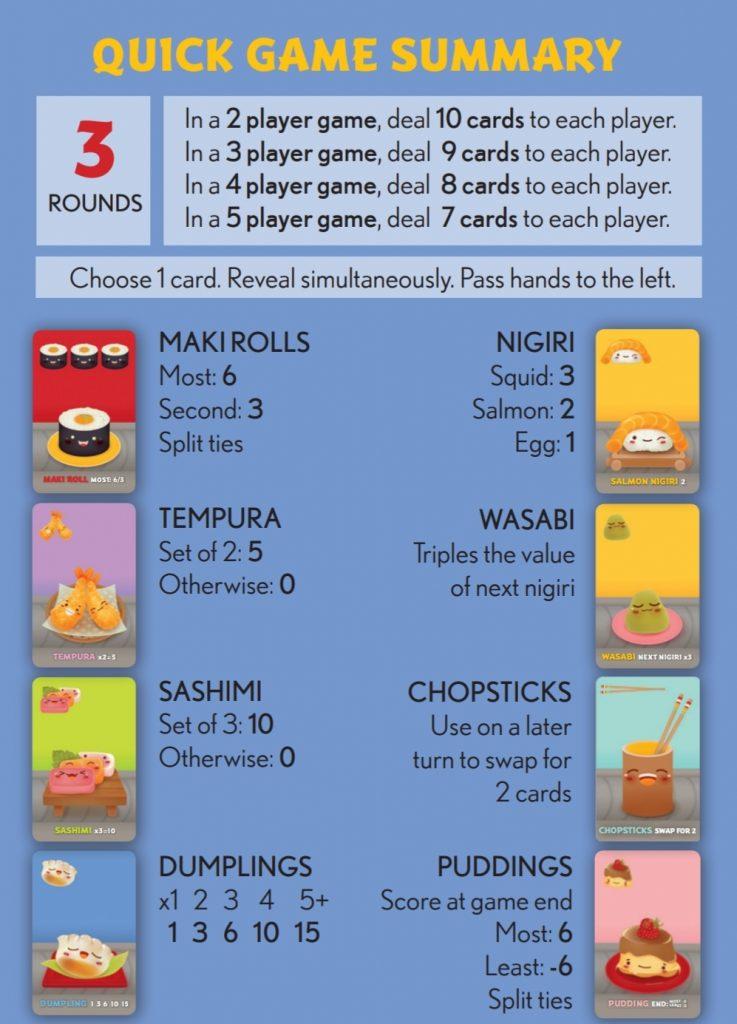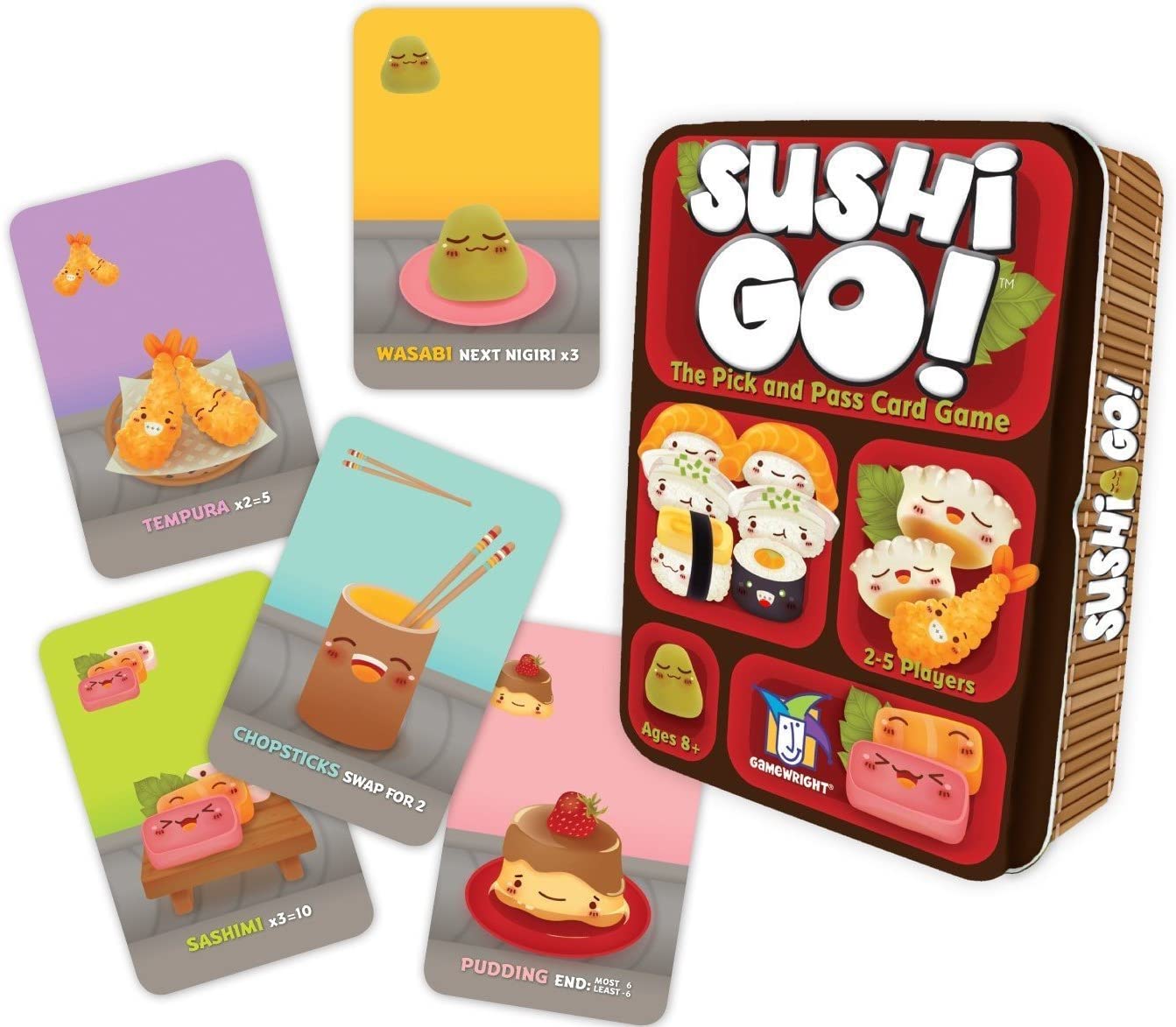After reading this article on game balance, I wanted to write about the card game Sushi Go!, designed by Phil Walker-Harding and published by Gamewright. The audience range is listed as 8+, but my first time playing this was in 247G this quarter as a junior in college, and I had a ton of fun playing! I think that the spontaneity and unpredictability of the game makes it fun for both kids and adults. I chose this game because it was memorable for being great and offered multiple strategies for success.
Formal Elements
Players & Roles:
Multi-player game for 2-5 players. Each player is playing to win and beat every other player.
Outcome & Objective:
The player with the most points wins, meaning it’s possible that the game ends in some sort of tie. You can also see the rankings of the placements because you can see how many points each player got.
Rules & Procedures:
Size of starting hand for each round depends on the number of players. The game is played in 3 rounds, and whoever has the most points at the end wins. Within a single round, each player simultaneously chooses 1 card to play and places that card down, face-up, before passing their hand to the left to continue to the round. Each card has a different value — for instance, a set of 3 Sashimi cards gets you 10 points, but anything less than that is worth 0 points. 1 Dumpling is worth 1 point, 2 are worth 3 points, 3 are worth 6, and so on. There are different strategies to boosting your score.
Resources & Boundaries:
You are constrained by the number of cards in the starting hand and by what you receive before playing each new card. Because you can never know exactly what hand will be passed to you, you have to stay on your toes, since you must play exactly 1 card each turn.

Type of Fun
For me, the fun of Sushi Go! was only made possible through the companionship and the reactions I saw/experienced throughout the game. This means that the type of fun was fellowship, which I definitely experienced. Because of the inherent “pass-and-play” mechanic of the game, you’re constantly interacting with other players, which contributes to the success of achieving fellowship fun.
Highs and Lows
The hectic nature of the game and the fact that my fate was not entirely in my control made it fun, since I never knew what I was going to get. I think that the base mechanic of pass-and-play worked really well.
As a player, it sucked when I came across a situation such as playing 2 Sashimis, then getting no more Sashimi cards and having my investment in this strategy go to waste. But I suppose this “Argh!” feeling goes to show that I was really into the game!
One aspect that took away from this “fun in the unknown” was when I played with only 2 players, since the hand I was given was only 1 card different from the hand I had just passed them. This made it easier to strategize and be able to plan in the long-term, even though I feel like a lot of the fun in this game stems from the spontaneity. I know it makes it less playable since you need more people, but I’d be curious what it’d be like if the player range was 3-5 instead of 2-5.
Four Types of Game Balance
- In single-player games: is the challenge level is appropriate?
- In multi-player games with asymmetry: does one starting position make it easier to win than another?
- In game with multiple strategies or paths to victory: is following one strategy is better or worse than following another?
- In a system that has several similar game objects: do different objects have the same cost/benefit ratio?
Since Sushi Go! is a multiplayer game in which each player gets a random starting hand of the same size, the first two types of balance don’t quite apply.
But this game is the perfect example of balance type 3, since there are multiple strategies or paths to victory that can be followed within the game. There are short term strategies, such as placing down a 3-point Nigiri and getting points for it immediately, versus long term strategies, such as gaining 6 points for having the most Maki rolls played of all the players in a round. I found that players opted to try different strategies throughout the different rounds, which signaled to me that there wasn’t a clear advantageous strategy. I also found good or bad luck with the different strategies based on the random hand I was passed on each turn, and this unpredictable hand plays a huge role in creating a strong balance in the game.

In Sushi Go!, the 3rd type of balance goes hand-in-hand with the 4th type of balance. If we consider each card as the game object, we can see how the different types of cards are playable in different ways, each having their own cost/benefit. Going the Nigiri route is safe, but has an overall lower payoff than “saving up” and banking on a Sashimi triple. Longer-term risk is rewarded with a higher point value, but short-term safety still allows for players to advance steadily in the game, creating a solid balance.
Three Ways to Balance Game Objects
Transitive
As mentioned above, Sushi Go! uses a cost curve to balance the game, in which risk/longer-term play is rewarded with higher point values that can be earned.
Intransitive
Sushi Go! also uses intransitive balance, since there are certain cards that are objectively superior to others. For instance, the Nigiri card has 3 forms: Squid (3 points), Salmon (2 points), and Egg (1 point, sorry vegetarians!). But, going back to the random starting hand and pass-after-each-turn mechanic, the game ends up balancing itself out even with these game objects of clearly different values.
Fruity
Even though the cards have entirely different functions in the way they are scored/played, I wouldn’t consider them so wildly different that the game fits into the fruity category.
Sushi Go! is a game I found through the class, but it was a huge inspiration in making our game for Project 1, and I’m definitely thinking about buying the game next time I go to Target or something 🙂



